 CLOUD
CLOUD
 CLOUD
CLOUD
 CLOUD
CLOUD
AWS re:Invent 2024 this past week ushered in a transformative chapter for both Amazon Web Services Inc. and the broader tech ecosystem.
This year’s event marked the debut of Matt Garman as chief executive of AWS, stepping into a role that aligns with what John Furrier aptly describes as a “wartime CEO” — a technically adept leader and trusted consigliere. Garman’s keynote set the tone for AWS’ strategic focus: doubling down on core infrastructure capabilities across silicon, compute, storage and networking, while extending its Graviton chip playbook to graphics processing units and potentially large language models.
Key highlights included the unveiling of six new artificial intelligence LLMs, formerly codenamed “Olympus” and now named Nova, introduced by none other than Andy Jassy, the godfather of cloud and now CEO of Amazon.com Inc., who made a cameo appearance with a substantive keynote. Jassy’s return underscored Amazon’s commitment to innovation at large scale, bridging its heritage in infrastructure with the future of AI.
A notable emphasis on simplification was palpable at this year’s event. Though the company remains steadfast in offering primitives, or granular services, and service flexibility, it’s now streamlining AI, analytics and data workflows into a unified view. This vision materialized with advancements in SageMaker, positioning it as a hub for machine learning, analytics and AI. Additionally, the event showcased a deluge of new features and services across AWS’ expansive ecosystem.
In this Breaking Analysis, we explore the critical takeaways from re:Invent 2024. Leveraging insights from Enterprise Technology Research data, we’ll unpack AWS’ strategy, the implications for the broader ecosystem, and how we believe the next several years will unfold.
One of the recurring themes in AWS’ journey has been its “primitives for builders” ethos — a foundational philosophy shaped by Amazon Chief Technology Officer Werner Vogels. At re:Invent 2021, this philosophy came under the spotlight as AWS navigated a market shift from tech-first early adopters to mainstream corporate developers who demand simplicity and pre-integrated solutions.
During the event, Vogels articulated the essence of AWS’ approach: Primitives provide unparalleled choice and power, enabling builders to craft virtually anything. However, he also acknowledged a critical tradeoff: As primitives proliferate without being inherently designed to fit together, they introduce complexity. This bottom-up approach starkly contrasts with the top-down strategy employed by competitors such as Microsoft Corp., which prioritizes simplification and abstracts away the complexity of underlying primitives.
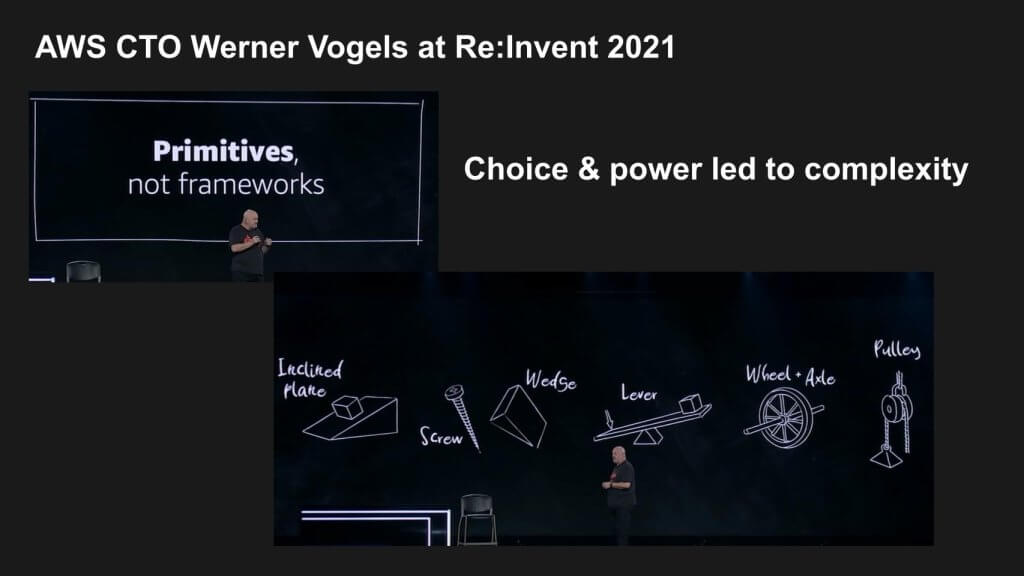
Former AWS CEO Adam Selipsky’s tenure at AWS attempted to address this tension by introducing a simplification narrative, beginning at re:Invent 2021. However, these efforts are akin to what Bill Gates said many years ago: When you have an architecture or a business model that you try to shift radically, it’s like kicking dead whales down the beach.
In other words, it’s a monumental shift that takes time to execute fully. Now, under Garman’s leadership, AWS is positioned to rationalize these seemingly competing philosophies, leveraging its traditional strengths while addressing the complexity concerns of mainstream enterprises.
AWS’ challenge remains clear: Integrating its extensive portfolio of primitives into cohesive solutions without sacrificing the flexibility that has long defined its identity. As the market continues to demand simplification, AWS must reconcile these competing forces to maintain its leadership.
AWS, under its new CEO Garman, is reasserting its dominance in core infrastructure while embracing the simplification imperative, for certain parts of its estate. This marks a significant evolution, blending AWS’ traditional ethos of “primitives for builders” with a shift toward pre-integrated, simplified solutions tailored for corporate developers.
One of the standout strategies involves leveraging Nitro and applying the AWS Graviton Playbook — originally devised to lower x86 compute costs — to GPUs and perhaps even LLMs. This year, AWS introduced six new LLM models called Nova, along with enhancements in SageMaker. These announcements underscore AWS’ commitment to lowering the cost of AI training and inference while reducing its reliance on Nvidia Corp.’s expensive GPUs. With Graviton, Trainium and Inferentia silicon offerings, AWS is making strides toward a more independent and cost-efficient AI strategy.
This approach has also allowed AWS to get on the generative AI training and inference learning curve at lower cost, using its own infrastructure (silicon and networking). We’ll come back to this point later in the post, but we see this as a significant competitive differentiator.
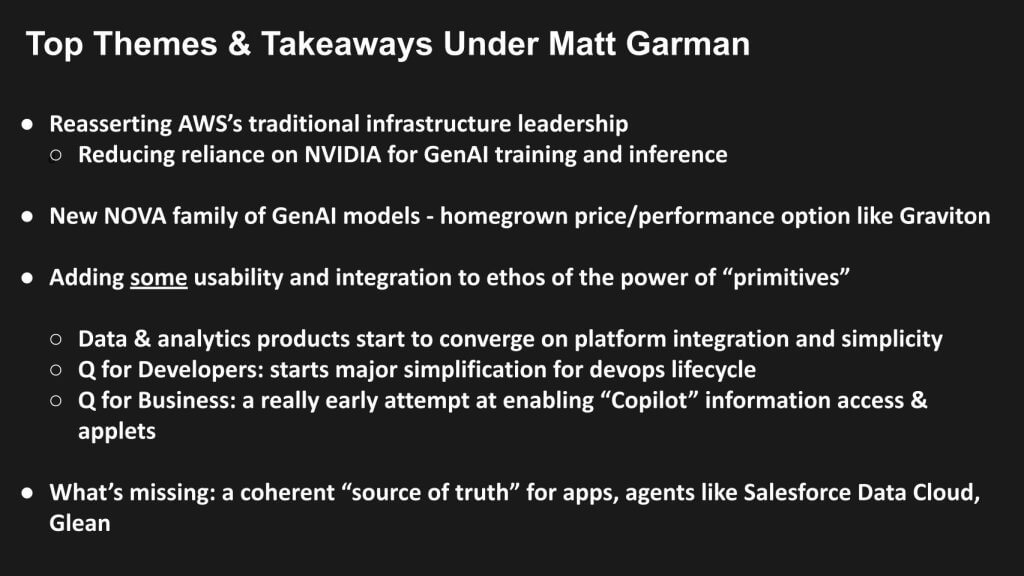
The irony of this shift is that AWS’ original “primitives-first” ethos left the perception that it was lagging behind in LLM infrastructure and, like others, was forced to rely on Nvidia. However, for the past two years, AWS has been able to gain critical learnings by evolving its AI infrastructure, using its lower-cost chips. Moreover, Garman’s leadership is now reaping the benefits of predecessor Selipsky’s simplification groundwork. AWS’ renewed focus on user-friendly, integrated solutions positions it to compete more effectively in the evolving enterprise market, in our view.
As AWS evolves, the simplification and choice positioning will remain central to its strategy. We’ll continue monitoring how this balance shapes AWS’s trajectory in AI, analytics, and infrastructure.
Garman brings a deeply technical background, having led EC2 for years. His leadership reflects AWS’ strategy of combining technical depth with a pragmatic approach to infrastructure. His tenure marks a shift from Selipsky’s operational focus, positioning AWS to capitalize on its extensive systems expertise. As the industry increasingly relies on AI-driven innovation, AWS is reasserting its dominance in silicon, networking and infrastructure, aiming to reduce dependency on Nvidia’s GPUs for AI training and inference.
This strategy stands in contrast to Microsoft’s approach, which has been limited by GPU constraints and a reliance on Nvidia’s supply chain. AWS’ silicon strategy changed dramatically when it started working with Annapurna Labs and eventually acquired the firm in early 2015.
Its silicon roadmap, including Graviton, Trainium and Inferentia, is focused on lowering costs and optimizing performance for AI workloads. The result? AWS is able to position itself aggressively as a leader in scalable, cost-effective AI infrastructure. Microsoft got started much later in its silicon journey and as such is more exposed to supplies of Nvidia GPUs.
Google LLC, like Amazon, has been on a custom silicon journey for more than a decade with its tensor processing unit or TPU, first deployed around the 2015 timeframe. Subsequently, Google has rolled out other silicon innovations and has a leading position in the space.
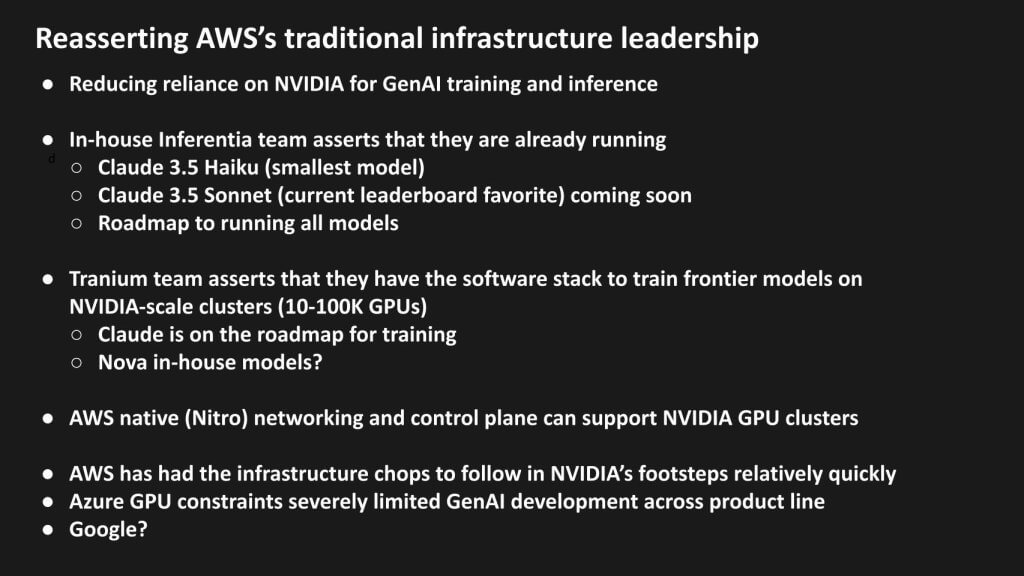
AWS’s Nitro system is a core differentiator. The company is able to deliver high-performance, Ethernet-based networking infrastructure optimized for AI workloads, avoiding reliance on Nvidia’s InfiniBand infrastructure. Nitro exemplifies AWS’ ability to integrate hardware and software into cohesive systems, and to a certain degree, replicate Nvidia’s systems-level approach to AI. Though Nvidia continues to lead in training at large scale — leveraging software beyond CUDA to optimize massive clusters — AWS is catching up by porting its entire Model Garden to Trainium-based clusters.
Anthropic PBC, with AWS as its primary cloud sponsor, represents a pivotal partnership. Though we believe much of the $8 billion investment in Anthropic includes cloud credits, the collaboration showcases AWS’ ability to support advanced models such as Claude 3.5 on Inferentia. This capability is a key step toward cracking Nvidia’s moat around inference, which has historically been a bottleneck for cloud providers. In short, despite some naysayers, we believe the Anthropic investment is working for both companies.
The gen AI revolution is reshaping every phase of the software development lifecycle. AWS, once perceived as a laggard in AI, now appears well-positioned to compete at large scale. By leveraging Nitro and its silicon expertise, AWS is aligning its infrastructure to support gen AI workloads effectively, even as it plays catch-up in areas such as large-scale training.
However, AWS’ systems expertise gives it a critical edge. While Microsoft struggles with GPU constraints and Google continues to lead in AI functionality, AWS is building a roadmap to independence. By optimizing its silicon and networking capabilities, AWS is on track to challenge Nvidia’s dominance and expand its AI offerings within its own ecosystem.
AWS’ focus on silicon and systems integration signals a long-term strategy to redefine AI infrastructure. Though Nvidia remains the leader in large-scale training, AWS’ accelerated progress in silicon and networking could erode that dominance, at least within the AWS installed base. With its Model Garden and advanced development tools maturing, AWS is proving that even lower-cost infrastructure can drive meaningful innovation.
Garman’s leadership will be pivotal in navigating this transition. AWS is no longer just following Nvidia’s footsteps; it is leveraging its systems expertise to chart a path forward that could reshape the competitive landscape of AI infrastructure.
At re:Invent, the introduction of the Nova family of gen AI models marked a significant milestone for AWS, signaling its intention to build leadership in the foundation model space. Jassy’s return to the stage to unveil these models was both a symbolic and strategic move, emphasizing AWS’ commitment to innovation and reinforcing its cultural and technical legacy.
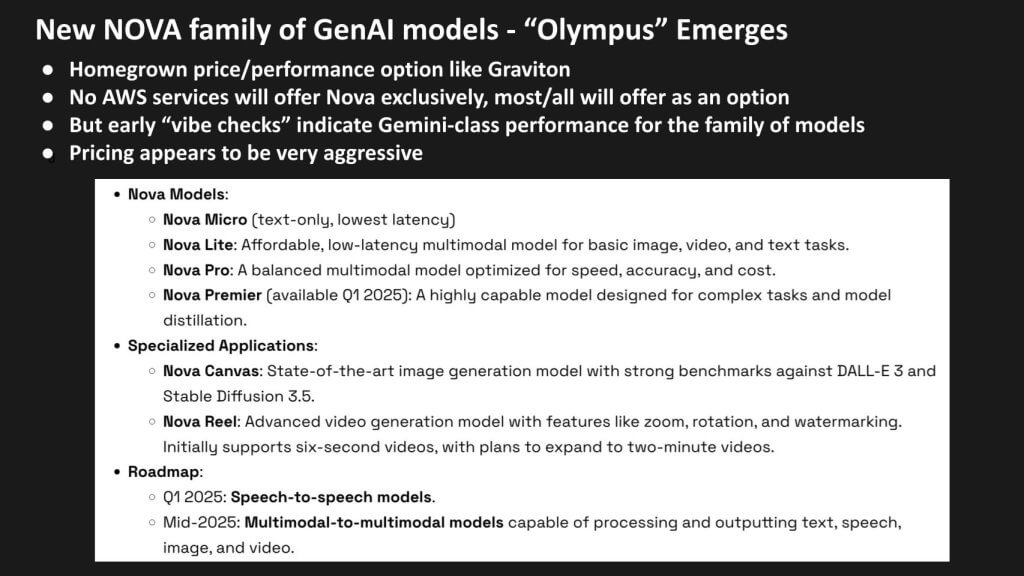
The Nova family, much like Graviton’s positioning against x86 chips, is designed to provide customers with optionality and competitive price-performance. AWS indicated to theCUBE Research that Nova models will not be exclusively tied to any AWS services, maintaining its ethos of flexibility and customer choice.
This, however, could also indicate an internal bias against Nova, which comes out of Amazon.com’s Alexa team. Our understanding is there were at least two competing teams for LLM leadership and it was decided that the Nova team was further along, so it won the resource battle.
Nonetheless, the roadmap and benchmarks for these models demonstrate Amazon’s ambition to compete head-on with industry leaders such as OpenAI, Google and Anthropic in gen AI, again, providing potentially lower-cost solutions for customers.
AWS’ entry into the foundation model game can be considered a strategic necessity. Just as the acquisition of Annapurna Labs laid the groundwork for in-house silicon development (such as Nitro and Graviton), the Nova family provides AWS with critical skills in gen AI, ensuring it remains competitive in a rapidly evolving market. This approach also positions AWS to offer differentiated solutions while gradually reducing its dependence on third parties for LLMs and training infrastructure.
The fine-tuning of Nova models on Trainium represents a deliberate effort by AWS to control costs and build independence in its AI strategy. As noted, though pretraining on Nvidia hardware remains standard due to its compute intensity, fine-tuning and inference — less resource-intensive phases — are being transitioned to AWS’ silicon.
This shift highlights AWS’ focus on cost-effectiveness, contrasting sharply with the high costs associated with training competitors’ models. For instance, Google’s Gemini Ultra reportedly cost nearly $200 million to train, underscoring the financial burden of building large-scale gen AI models.
AWS appears committed to a long-term strategy of innovation in GenAI. While still leveraging Nvidia for pretraining, its investments in Trainium and other in-house silicon solutions position it to gradually reduce reliance on external vendors. The Nova models are an essential step in building the technical and operational capabilities required to compete in an increasingly AI-driven world.
With a clear roadmap, competitive pricing and a focus on optionality, AWS is signaling that it is not just participating in the gen AI race but is determined to shape its trajectory.
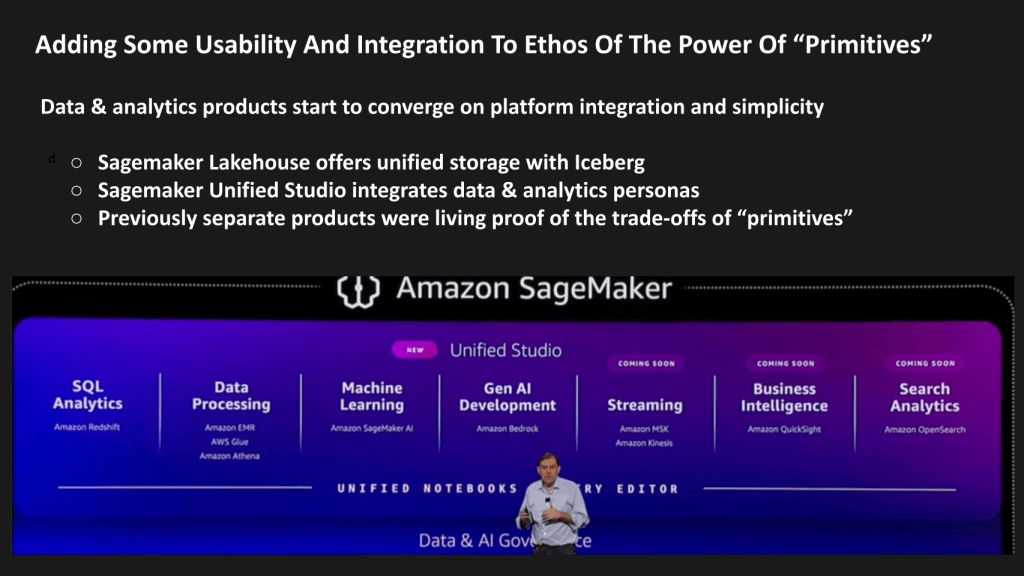
AWS continues to push forward in the data and analytics space, balancing its core ethos of power primitives with the industry’s demand for simplification. At re:Invent, Amazon unveiled significant updates to SageMaker, signaling its ambition to redefine the data and analytics landscape. Historically, AWS’s data platform struggled to compete as a cohesive solution. The updates position SageMaker as a robust, unified platform, aimed at simplifying workflows for data and analytics professionals while preserving flexibility for developers.
Summary of Snowflake’s take on the AWS announcements: Snowflake underscored its growing partnership with AWS, citing 68% year-over-year growth in bookings and recognition with nine AWS re:Invent 2024 awards, including “Global Data and Analytics ISV Partner of the Year.” The collaboration spans integrations like Snowpark for Python with SageMaker and joint work on Apache Iceberg to enhance data interoperability, reduce complexity and mitigate vendor lock-in.
Snowflake’s unified platform approach, supported by its Datavolo acquisition, accelerates AI application development and maintains robust governance through its Horizon Catalog. Highlighting AWS SageMaker’s recent improvements and its shared commitment to Apache Iceberg, Snowflake announced a multiyear partnership with Anthropic to integrate Claude 3.5 models into its Cortex AI platform on AWS and expressed plans to deepen collaboration in analytics and AI innovation.
Our take on Snowflake’s response is it’s no surprise the company would put forth an optimistic stance. As well, Snowflake and AWS (and Databricks) have shown this is not a zero-sum game. At the same time, we continue to feel that Snowflake’s primary competitive advantage is its integrated experience and the quality of its core database. As we’ve previously discussed, the value is shifting up the stack toward the governance catalog, which is becoming more open. This in our view will push Snowflake in new directions, which its response acknowledges.
From the Databricks perspective, we believe what AWS announced validates much of that which Databricks CEO Ali Ghodsi has been espousing, that open formats will win and customers want to bring any compute to any data source.
As AWS moves more toward a unified data platform, metadata emerges as the key value layer. This harmonization or semantic layer transforms technical metadata into business-relevant information — people, places, things and their relationships.
Skepticism remains about AWS’ ability to execute at this level of integration. Industry experts have previously doubted Amazon’s capability to unify its platform effectively. However, the reimagined SageMaker, with its unified storage and metadata layers, represents a meaningful step forward.
The updates will intensify competition with Snowflake, Databricks and others in the battle for enterprise data dominance. As AWS builds out its platform, market confusion could grow as enterprises weigh the benefits of SageMaker versus other well-established data platforms.
The new and improved SageMaker signals AWS’ commitment to delivering a unified platform that simplifies workflows without sacrificing power. While competitors like Snowflake and Databricks have led the charge in unifying tools and storage, AWS is rapidly closing the gap by converging data, analytics and AI capabilities under one umbrella.
AWS’ roadmap points toward greater integration, including knowledge graph capabilities and semantic layers. By bridging its infrastructure expertise with application-centric design, AWS is positioned to redefine how enterprises harness the power of their data.
This evolution will determine whether AWS can shift from a fragmented toolkit provider to a leader in unified data platforms. The stakes are high because we believe ultimate agentic architectures won’t scale without this harmonization capability. We believe Amazon is laying the foundation with SageMaker and AWS is prepared to compete at the highest levels of the data ecosystem.
AWS continues to bridge its core ethos of “primitives for builders” with the need for usability and integration. A standout example of this strategy is Q Developer, a suite aimed at transforming the software development lifecycle by introducing agents that automate noncoding tasks such as documentation, unit testing and code reviews. This represents a major step forward in simplifying cloud and AI development, making these capabilities more accessible to developers and enterprises alike.
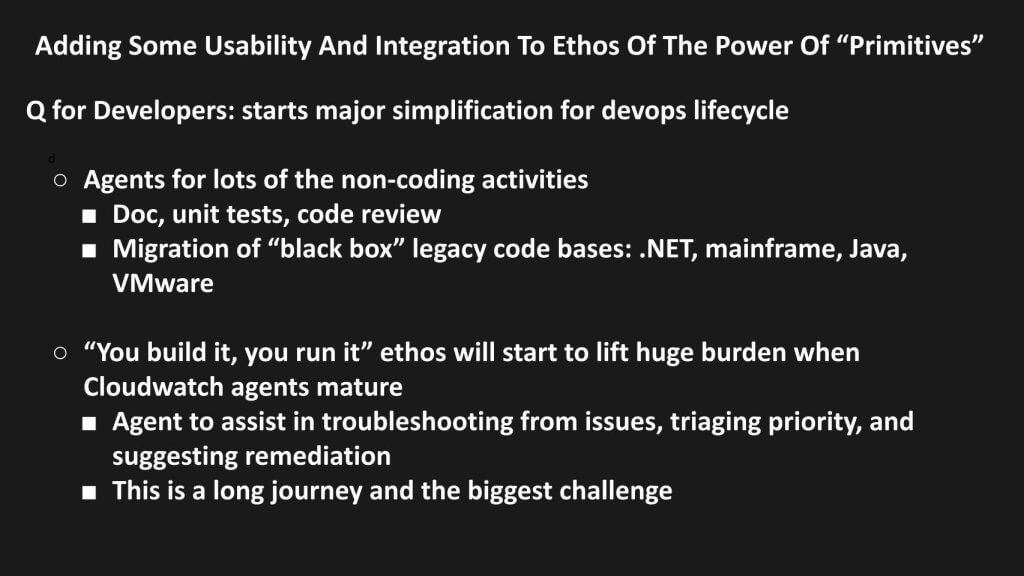
At the same time, AWS is pursuing legacy modernization efforts, targeting workloads like mainframes, Windows/.NET, and VMware, with varying degrees of success and challenges. Though these efforts showcase AWS’ ambition, the real headline is the growing ecosystem around gen AI-powered development agents, which AWS is integrating into its services, signaling a new era of productivity and accessibility for developers.
As cloud evolves, so too does the role of developers. While they have long been the “kingmakers” in cloud, the rise of gen AI and low-code tools signals a shift in focus toward data-centric application development. In this context:
The interplay between gen AI agents and harmonized metadata is central to this usability revolution. By integrating operational and technical metadata, AWS is creating a framework where agents can navigate seamlessly across datasets and services. This approach aligns with the broader vision of an AI-driven development ecosystem:
AWS’s Q Developer and its integration of gen AI agents signal a paradigm shift in how cloud development is approached. By combining the power of primitives with enhanced usability, AWS is paving the way for a more accessible and productive development environment. This effort positions AWS to compete not just with traditional cloud competitors but also with platforms that emphasize low-code, AI-driven workflows.
As the market evolves, the battle will increasingly focus on usability and integration, where AWS, Microsoft, Salesforce and others compete to define the next generation of software development. AWS’ success will hinge on its ability to harmonize its deep infrastructure expertise with the growing demand for developer and enterprise simplicity.
Q Business represents a nascent attempt to bring “Copilot”-like functionality to the enterprise, echoing Microsoft 365 Copilot’s promise. This early iteration from AWS seeks to unify collaboration and business data under a single index, enabling LLM queries. The potential benefits are substantial but in our view will take more time to evolve:
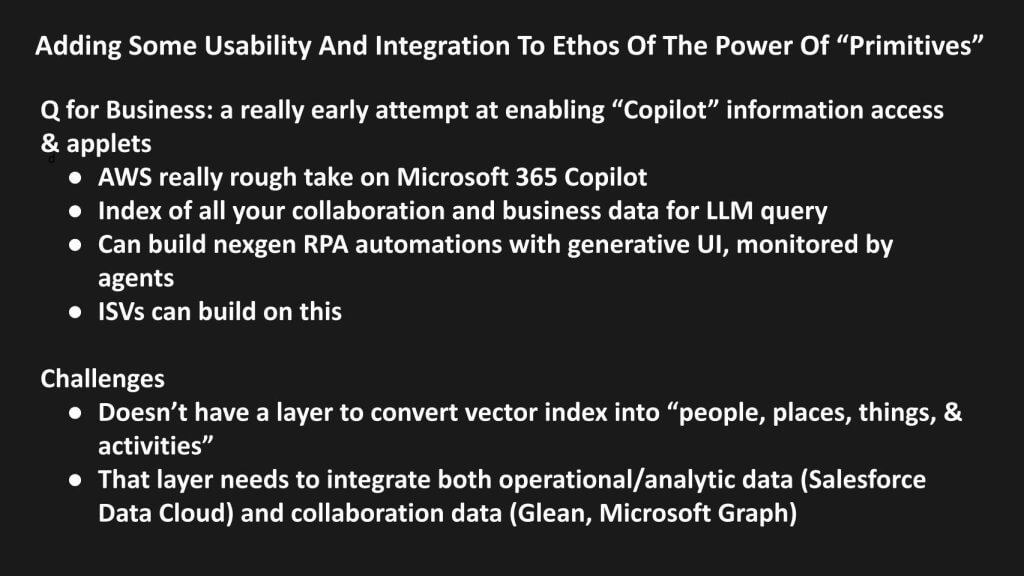
However, Q Business faces significant hurdles:
As Q Business continues to evolve, addressing these challenges will be crucial to realizing its vision of streamlined information access and automation.
The chart below provides a classic view into spending momentum and market penetration within the machine learing and AI ecosystem. Using ETR data from 1,775 enterprise information technology decision-makers, the vertical axis reflects Net Score, a measure of spending momentum —essentially the percentage of customers increasing their spending on a platform. The horizontal axis, labeled as Overlap, represents penetration within the surveyed accounts. Together, these metrics highlight both platform momentum and adoption across the ML/AI market. The red line at 40% on the vertical axis represents a highly elevated Net Score.
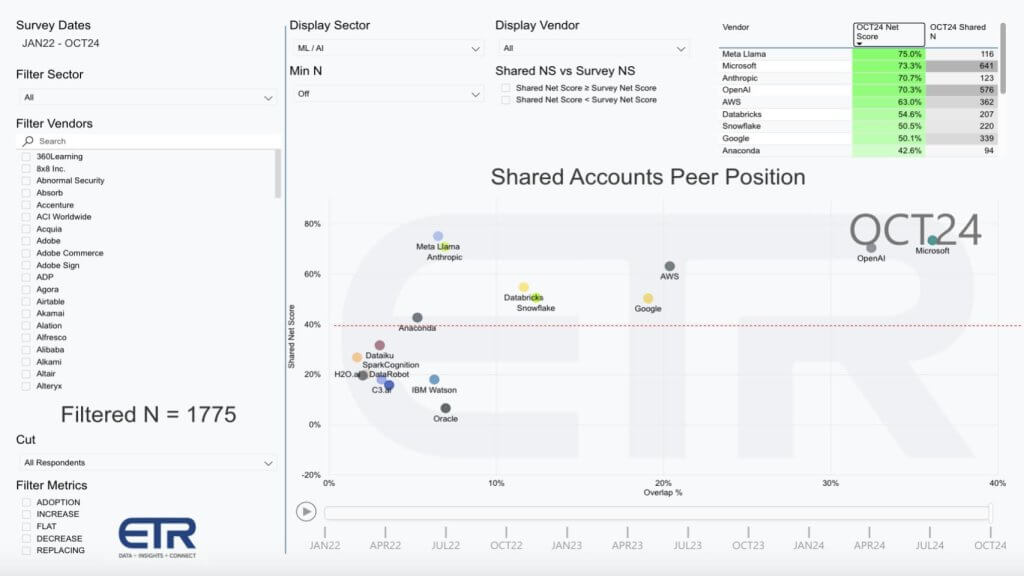
This snapshot of the ML/AI sector highlights a evolving competitive landscape where foundational model players such as OpenAI, Meta Llama and Anthropic are redefining the space. Data-centric platforms such as Databricks and Snowflake are integrating AI to remain competitive, while legacy players such as IBM and Oracle are fighting to stay relevant.
AWS Nova models may move the needle, but it’s likely Anthropic will continue to be the dominant platform in the ETR data AWS will in our view continue to exert influence through Bedrock and its other partnerships and its optionality strategy is playing out as planned. As enterprises increasingly view AI as foundational to their strategies, the momentum and penetration of these platforms will shape the next wave of innovation in the ML/AI ecosystem.
The evolving software stack (shown below) is pushing beyond traditional silos of infrastructure, platform services and software-as-a-service applications. We believe the imperative for the next decade is the creation of a harmonization layer — a transformative new abstraction that orchestrates end-to-end business processes, aligning activities such as demand forecasting, internal operations and supplier coordination into a seamless whole.
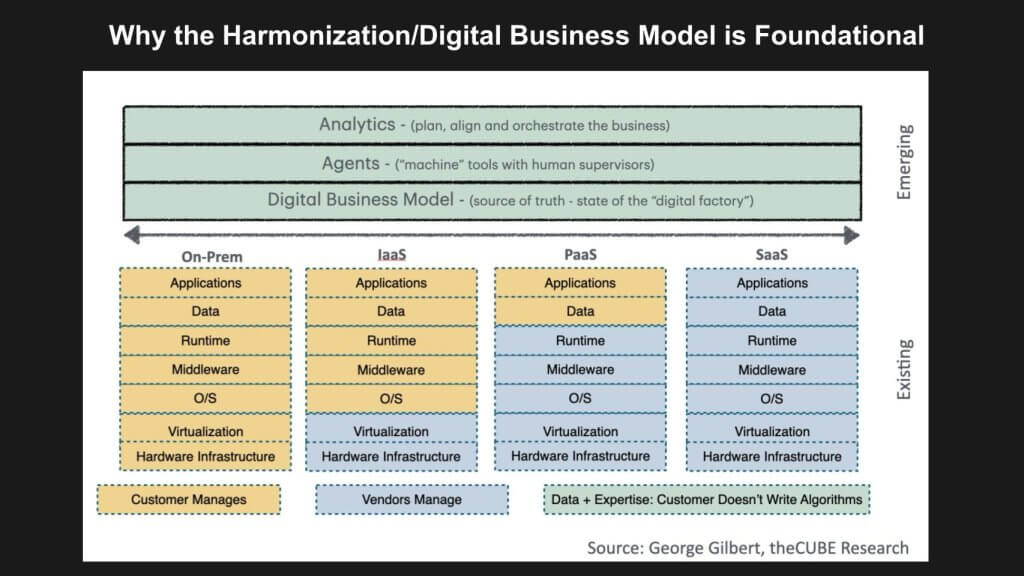
We describe this vision as a “virtual assembly line of expertise,” which seeks to achieve for managerial and collaborative work what the physical assembly line did for manufacturing a century ago: Optimize throughput, eliminate inefficiencies and enable expertise to flow seamlessly across the organization.
This new harmonization layer represents a seismic shift in enterprise IT. By extending the concepts of databases and enterprise resource planning systems (for example, Oracle and SAP SE) across the entire data and application estate, this layer creates a predictive, interconnected framework that transcends traditional silos.
The emergence of the harmonization layer is nothing short of transformative, redefining how enterprises align their processes and leverage expertise. However, this evolution is still in its early stages, with significant challenges in governance, agent integration and metadata harmonization.
As AWS, Microsoft and startups such as Glean, Celonis and Kubiya push the boundaries of this sector, the journey will define the next generation of application platforms. Though the payoff may take a decade or more, the potential to revolutionize enterprise productivity and collaboration is undeniable.
What do you think? Did you catch the action at AWS re:Invent 2024? What caught your attention that we didn’t touch upon? Are there things in this research note you disagree with or to which you can add context?
Let us know.
Support our mission to keep content open and free by engaging with theCUBE community. Join theCUBE’s Alumni Trust Network, where technology leaders connect, share intelligence and create opportunities.
Founded by tech visionaries John Furrier and Dave Vellante, SiliconANGLE Media has built a dynamic ecosystem of industry-leading digital media brands that reach 15+ million elite tech professionals. Our new proprietary theCUBE AI Video Cloud is breaking ground in audience interaction, leveraging theCUBEai.com neural network to help technology companies make data-driven decisions and stay at the forefront of industry conversations.